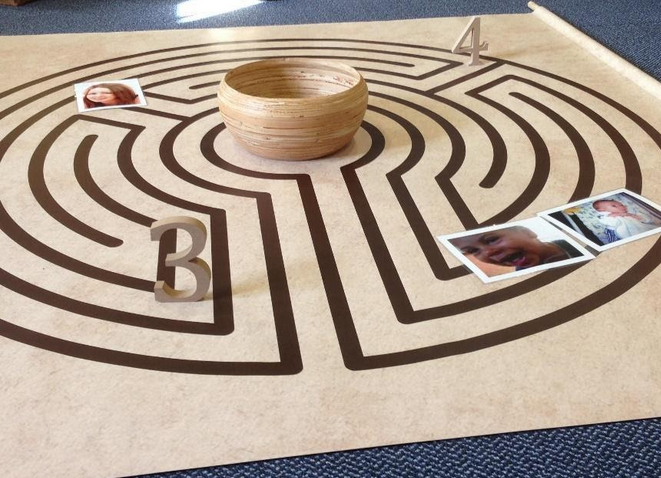One of the joys of delivering Sandstories training is that I am able to draw on many different creative sources to illustrate the stories of real children, so that they can encourage us to strengthen our child-centred practice.
In telling their stories, these children cease being simply “cases” and instead can speak of their lived experience, even though their lives have been cut short.
Using a large labyrinth, rolled out on the floor, has been one of the storytelling techniques I have used to help us listen to the distant voices of children and young people. They remind us of our deep desire to be child-centred in our work with the children we know.
At first glance, a labyrinth looks a little like a maze – you know, the kind of thing that you find in a children’s puzzle book. But a labyrinth is different.
A maze is designed to make us lose our way, whereas a labyrinth helps us to find our way.
It’s impossible to get lost in a labyrinth, the path will always lead to the centre.
The labyrinth comes in different designs, is about 4,000 years old, and is found all over the world.
Ideally, the labyrinth will be large enough for people to physically walk on, either outdoors, or perhaps on the floor of a holy building or in some other communal space. The Sandstories labyrinth isn’t quite as big as this – or else I would never be able to find a venue large enough to accommodate the training! But it is certainly big enough to bring children’s stories to life.
Some people use a labyrinth to explore their life journey, others their spiritual journey, and others may simply want to reflect on a particular time in their life or a decision they are trying to make.
Those who walk a labyrinth are encouraged to pause and reflect as they travel towards the centre, listening to the deep-rooted questions that are arising for them.
As I use the Sandstories labyrinth, I share stories of real children to help us pause and reflect – I often bring the children’s photographs onto the labyrinth too. This creates a very special and intimate space for everyone present to really listen to the child’s description of their life.
This rare opportunity to draw alongside children and young people whom we have never met, allows us to grow in our insight and wisdom. We can then offer this to the children who cross our path, with refreshed child-centred practice.
Importantly, reflective practice works both ways. Whilst we reflect on the lives of vulnerable children and examine how we can best respond to them, we also need space to reflect on ourselves. What do we need to keep going and how we can hold onto resilience in the face of adversity?
It almost feels like a luxury to be able to step away from the usual commotion of the working day to be able to pause and reflect on why we have chosen to do the job we do. What is it about the lives of vulnerable children and young people that makes its mark on us? Why do we keep going when we so often feel exhausted and wonder whether we are making any difference at all?
There are many sources of advice and guidance on how to care for our mental health, our physical health and our emotional wellbeing. Within my training, I have shared the Sandstories labyrinth to support our professional and personal reflection, to help build and maintain our resilience.
“Unless you can create an inner sanctuary, a special chamber within, where you can be with yourself, slow things down, and direct your thoughts towards what nourishes you in body, mind, and spirit, you will be starving for meaning and purpose in your life. The labyrinth can help you create this inner chamber; it can provide a touchstone to return to when you need to remember who you are and where and with whom you stand.”
The Scared Path Companion, Lauren Artress, 2006
If you would like to learn more about labyrinths, this website might interest you:
https://labyrinthsociety.org/
This labyrinth can be found at the Quaker Woodbrook Centre.
This is the Sandstories labyrinth.
